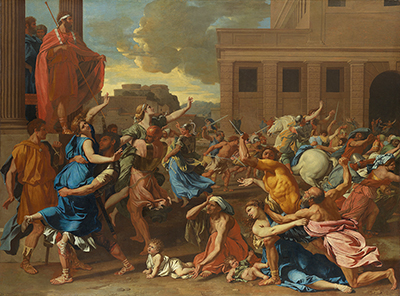The Rape of the Sabine Women is the title of not only this painting: it also describes a horrendous incident in history. The founding of Rome in around 800BC by Romulus – one of the famed wolf-raised twins – meant that the city was in danger of collapsing almost before it had a chance to establish itself properly.
This was because most of these early Romans were male, and the serious dearth of women – and therefore heirs – threatened that the city would not survive their passing. Romulus sent word to all the surrounding tribes, especially the Sabines who were a large presence, close to the fledgling settlement that would become Rome, asking for their daughters as spouses for the men. Scared of the potential might of this newcomer to the area, the Sabines refused this request, and persuaded the other tribes to do the same, hoping that would be enough to encourage the Romans to go elsewhere to settle down.
In this, they very badly misjudged the Romans who simply marched on the Sabine villages and took the women, seizing wives and daughters and forcibly marrying them. The Romans being the victor in this battle, it was recorded in as good a light as possible, but nevertheless, the event resounded through history, with many artists inspired by the dramatic tale of power, conflict and sex to write or paint about it. Nicolas Poussin was so moved by the narrative that he painted it not once but twice – one painting called 'The Abduction of the Sabine Women', while the other uses the word rape in the title.
In the painting, the Romans are captured in the act of seizing as many young, child-bearing age women as they can. This testament to their fertility is symbolised by the two babies, who have been tumbled out of the arms of their mothers, lying disconsolate in the foreground, overseen by an elderly woman who seems to be offering them no comfort. Poussin possibly included two babies of a similar look and age in order to offer a nod to the origin story of ancient Rome – the two babies marked for death by their father, saved by a river god and placed into the care of a she-wolf who went on to found a fabulous empire. Or at least one of them did... Romulus, or one of his followers, is said to have killed Remus following a dispute on the placement of Rome.
Poussin's rendering of the struggle: the despair etched on the faces of the women being taken as well as those left behind; the brutish determination of the well-armed Romans, in red and gold, against unprotected villagers, whose clothing is picked out in beautiful soft colours – all tells a tale that makes clear that despite the success of the mission, the event itself was abhorrent and to be condemned by all.




